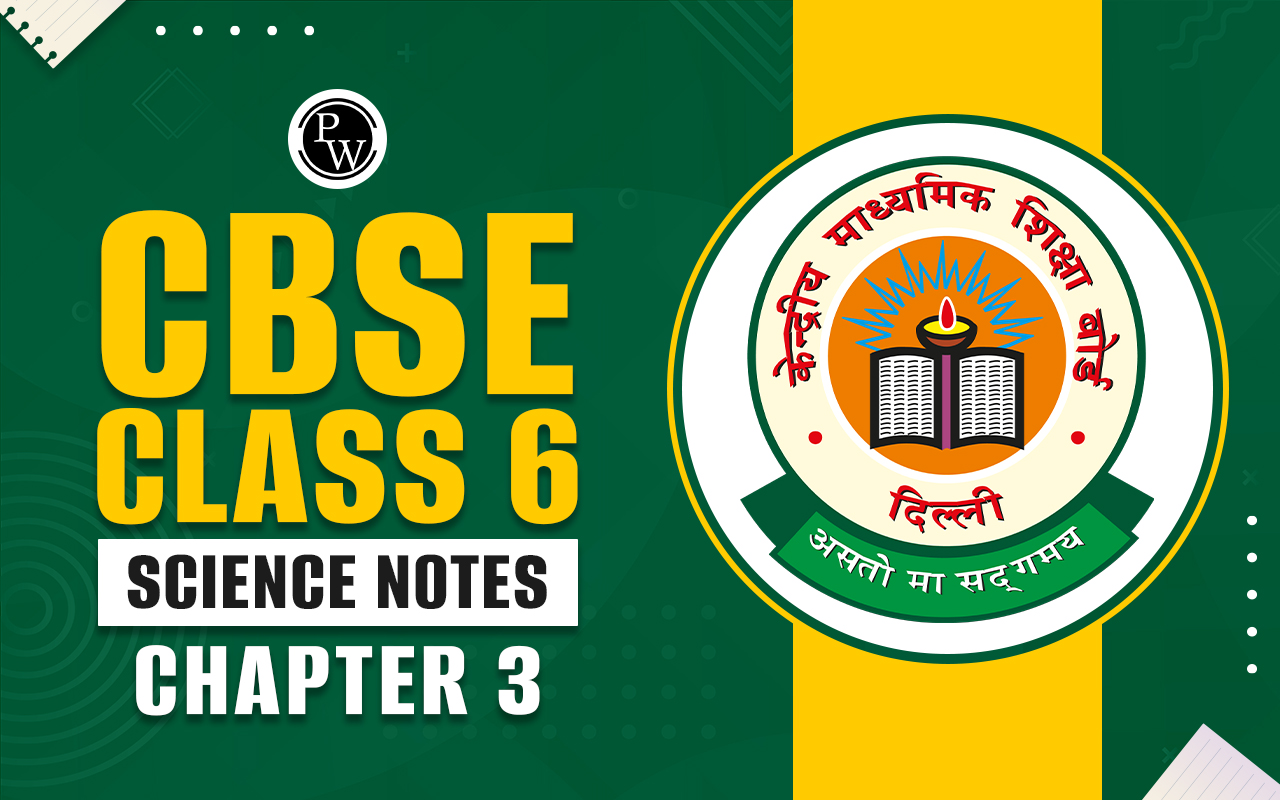

CBSE Class 6 Science Notes Chapter 3
CBSE Class 6 Science Notes Chapter 3: The NCERT Solutions for Class 6 Science provided by Physics Wallah are highly dependable study materials. Our expert tutors, who hail from prestigious universities, have meticulously crafted the NCERT Class 6 Science Solutions to ensure they are easily comprehensible. These solutions offer precise answers to all exercise questions and elucidate concepts in a detailed, step-by-step manner. Access the NCERT Solution for Class 6 Science as free PDF downloads to bolster your exam preparations. Additionally, you can also avail NCERT Solutions for Class 6 Maths to comprehensively revise the entire syllabus and achieve higher scores in your examinations.CBSE Class 6 Science Notes Chapter 3 Overview
Are you struggling to understand the complex concepts of fibers and fabrics in your CBSE Class 6 Science class? Look no further! In this detailed blog post, we will provide you with comprehensive notes on Chapter 3 - Fibre to Fabric. From the basics of natural and synthetic fibers to the process of making fabric, we have covered everything you need to know to ace your exams. So grab your notebooks and let's dive into the world of Fibre to Fabric!CBSE Class 10 Science Sample Paper 2023-24
CBSE Class 6 Science Notes Chapter 3 Fibre to Fabric Notes
Here are CBSE Class 6 Science Notes Chapter 3 - Fibre to Fabric notes in detail: 1) Introduction to Fibre to Fabric:- Fibres are thin, thread-like structures that can be spun into yarn and then woven into fabric.
- Fabrics are materials made by weaving, knitting, or bonding fibres together.
- Natural Fibres: These are obtained from plants (cotton, jute, hemp) and animals (wool, silk).
- Synthetic Fibres: These are man-made fibres produced from chemicals (nylon, polyester, acrylic).
- Cotton: Obtained from the cotton plant's seed pod (boll), cotton fibres are soft, breathable, and absorbent. They are used to make clothes, bed sheets, and towels.
- Silk: Produced by silkworms, silk fibres are strong, smooth, and lustrous. They are used to make luxurious fabrics, sarees, and garments.
- Wool: Obtained from the fleece of sheep, wool fibres are soft, warm, and elastic. They are used to make sweaters, shawls, and blankets.
- Jute: Derived from the stem of the jute plant, jute fibres are strong, coarse, and golden brown. They are used to make sacks, ropes, and mats.
- Cotton: After harvesting, cotton bolls are ginned to separate the seeds from the fibres. The fibres are then spun into yarn and woven into fabric.
- Silk: Silkworms produce silk fibres in their cocoons. The cocoons are boiled in hot water to soften the silk fibres, which are then unwound, spun into yarn, and woven into fabric.
- Wool: Sheep are sheared to obtain wool from their fleece. The wool is cleaned, carded (combed), spun into yarn, and woven into fabric.
- Strength: Some fibres are stronger than others. For example, silk is stronger than cotton.
- Durability: Fibres like nylon and polyester are durable and long-lasting.
- Comfort: Natural fibres like cotton and wool are comfortable to wear as they are breathable and absorbent.
- Elasticity: Wool fibres have natural elasticity, making them stretchable and resilient.
- Clothing: Fabrics are used to make clothes for protection, comfort, and fashion.
- Home Furnishings: Fabrics are used for making curtains, upholstery, bed linens, and carpets.
- Industrial Purposes: Fabrics are used in industries for making bags, ropes, filters, and insulation materials.
- Weaving: Weaving is the process of interlacing two sets of yarns or threads at right angles to create fabric. It involves a warp (longitudinal) and weft (transverse) yarn. Fabrics like cotton and silk are often produced through weaving.
- Knitting: Knitting involves interlocking loops of yarn to create fabric. It is commonly used to produce garments like sweaters, socks, and hats. Wool and synthetic fibres are often knitted into fabrics.
- Felting: Felting is a process where wool fibres are compressed and matted together using heat, moisture, and agitation. This technique creates non-woven fabrics used in applications like hats, boots, and carpets.
- Denim: Denim is a sturdy cotton twill fabric, typically used for making jeans, jackets, and skirts. It is known for its durability and rugged appearance.
- Velvet: Velvet is a luxurious fabric with a soft, dense pile. It is often used for upholstery, evening wear, and accessories due to its rich texture and appearance.
- Satin: Satin is a smooth, glossy fabric with a lustrous surface. It is commonly used for formal wear, lingerie, and linens, imparting an elegant and luxurious feel.
- Linen: Linen is a lightweight, breathable fabric made from the flax plant. It is prized for its coolness and freshness, making it suitable for summer clothing and home textiles.
- Natural Fibres: Natural fibres like cotton and wool are biodegradable and eco-friendly. However, their production may involve significant water and pesticide usage, impacting the environment.
- Synthetic Fibres: Synthetic fibres like polyester and nylon are non-biodegradable and contribute to environmental pollution. Their production also involves the use of fossil fuels and chemicals, leading to carbon emissions and waste generation.
- Sustainable Fabrics: There is a growing demand for sustainable and eco-friendly fabrics made from renewable sources like bamboo, hemp, and organic cotton. These fabrics minimize environmental impact and promote ethical production practices.
- Smart Fabrics: Advancements in textile technology have led to the development of smart fabrics embedded with sensors and electronics. These fabrics have applications in healthcare, sports, and fashion, offering functionalities like temperature regulation and activity monitoring.
| CBSE Syllabus Class 6 | |
| CBSE Class 6 Science Syllabus | CBSE Class 6 Maths Syllabus |
| CBSE Class 6 Social Science Syllabus | CBSE Class 6 English Syllabus |
CBSE Class 6 Science Notes Chapter 3 Fibre to Fabric Important Topics
CBSE Class 6 Science Chapter 3 - Fibre to Fabric covers a wide range of important topics related to the production and utilization of fibres in textile manufacturing. Here's a detailed exploration of each of these key topics: 1) What is Fibre?- Fibre refers to a thin, thread-like structure that is the basic unit of textile materials.
- It can be natural or synthetic and is used to make fabrics and other textile products.
- Fibres can be broadly classified into two types: natural fibres and synthetic fibres.
- Natural fibres are obtained from plants and animals, while synthetic fibres are man-made and derived from chemical substances.
- Natural fibres include cotton, wool, silk, jute, and linen, among others.
- Each natural fibre has its unique properties and characteristics, making it suitable for specific applications.
- Fibres obtained from plants include cotton, jute, hemp, and flax.
- Cotton is the most widely used plant fibre, known for its softness, breathability, and absorbency.
- Jute is a coarse fibre used for making sacks, bags, and ropes.
- Fibres obtained from animals include wool and silk.
- Wool is derived from the fleece of sheep and is valued for its warmth, elasticity, and moisture-wicking properties.
- Silk is produced by silkworms and is known for its smooth texture and luxurious appearance.
- Cotton yarn is produced through a process called spinning, where cotton fibres are twisted together to form a continuous strand.
- This yarn is then used to weave fabrics like cotton cloth and denim.
- Yarns are interlaced or knitted together to create fabrics through processes like weaving and knitting.
- Weaving involves interlacing yarns at right angles to form a fabric, while knitting involves interlocking loops of yarn.
- Fabrics are further processed and treated to achieve desired properties like softness, durability, and colorfastness.
- The history of clothing material dates back to ancient times when humans used natural fibres like animal hides, plant leaves, and tree bark to cover themselves.
- Over time, advancements in textile production led to the development of techniques for spinning, weaving, and dyeing fibres, resulting in a wide variety of clothing materials.
CBSE Board Exam Centre List 2024
CBSE Class 6 Science Notes Chapter 3 Fibre to Fabric Important Questions
Here are some important questions related to Chapter 3 - Fibre to Fabric in CBSE Class 6 Science: 1) What is a fibre? Provide examples of natural and synthetic fibres. A fibre is a thin thread-like structure that is used to make fabric. Examples of natural fibres include cotton, wool, silk, and jute, while examples of synthetic fibres include polyester, nylon, and acrylic. 2) Explain the process of obtaining fibres from plant sources. Give examples of plant fibres and their uses. Fibres from plant sources are obtained from various parts of plants, such as seeds, stems, and leaves. For example, cotton fibres are obtained from cotton bolls, jute fibres are obtained from the stem of the jute plant, and coir fibres are obtained from the outer husk of coconuts. These plant fibres are used to make textiles, ropes, and mats. 3) How are fibres obtained from animal sources? Provide examples of animal fibres and their characteristics. Fibres from animal sources are obtained from animals such as sheep, goats, and silkworms. Wool is obtained from the fleece of sheep, while silk is obtained from the cocoons of silkworms. These animal fibres are known for their warmth, softness, and durability. 4) Describe the process of spinning cotton yarn. What are the properties of cotton fibre that make it suitable for spinning? Cotton yarn is spun from cotton fibres using a spinning wheel or machine. Cotton fibres are long, soft, and flexible, which makes them easy to spin into yarn. Additionally, cotton fibres have good moisture absorption properties, which makes cotton yarn comfortable to wear. 5) What is the difference between natural and synthetic fibres? Provide examples of each and discuss their advantages and disadvantages. Natural fibres are obtained from plants and animals, while synthetic fibres are made from chemical substances. Natural fibres are biodegradable and breathable, but they may be less durable than synthetic fibres. Synthetic fibres, on the other hand, are often more durable and resistant to wrinkles and pests, but they are not biodegradable and may be less comfortable to wear. 6) Explain the process of converting yarn into fabric. Discuss the different methods of fabric production. Yarn is converted into fabric through processes such as weaving, knitting, and felting. Weaving involves interlacing yarns to create a fabric, while knitting involves interlocking loops of yarn. Felting involves matting fibres together using heat, moisture, and pressure. 7) What is weaving? How is it different from knitting? Provide examples of fabrics produced through weaving and knitting. Weaving is a method of fabric production in which two sets of yarns are interlaced at right angles to each other to create a fabric. Knitting, on the other hand, involves interlocking loops of yarn to create a fabric. Examples of fabrics produced through weaving include cotton and silk, while examples of fabrics produced through knitting include wool and acrylic. 8) Discuss the historical significance of clothing materials. How have advancements in technology influenced the production of fabrics over time? Clothing materials have played a significant role in human history, serving as protection against the elements and as a form of cultural expression. Advancements in technology, such as the invention of the spinning wheel and the power loom, have made fabric production more efficient and have led to the development of new types of fabrics. 9) What are the environmental impacts of fabric production? How can we promote sustainable practices in the textile industry? Fabric production can have significant environmental impacts, including pollution of waterways, deforestation, and greenhouse gas emissions. To promote sustainable practices in the textile industry, companies can use eco-friendly production methods, recycle materials, and reduce waste. Consumers can also support sustainable brands and choose clothing made from organic or recycled materials. 10) Explain the concept of smart fabrics. What are their potential applications in various fields? Smart fabrics are textiles that have been enhanced with technology to provide additional functionalities, such as temperature regulation, moisture management, and biometric monitoring. These fabrics have potential applications in various fields, including sports and fitness, healthcare, and military and defense. 11) What is weaving? How is it different from knitting? Weaving is a method of fabric production in which two sets of yarns are interlaced at right angles to create a fabric. Knitting, on the other hand, involves interlocking loops of yarn to create a fabric. Weaving produces fabrics like cotton and silk, while knitting produces fabrics like wool and acrylic. 12) What are the properties of wool that make it suitable for clothing? Wool has several properties that make it suitable for clothing, including warmth, insulation, moisture-wicking, and elasticity. It is also naturally fire-resistant and has antimicrobial properties. 13) What are the environmental impacts of fabric production? Fabric production can have significant environmental impacts, including pollution of waterways, deforestation, and greenhouse gas emissions. Sustainable practices, such as using eco-friendly materials and reducing waste, can help minimize these impacts. 14) What are smart fabrics? Smart fabrics are textiles that have been enhanced with technology to provide additional functionalities, such as temperature regulation, moisture management, and biometric monitoring. They have applications in various fields, including sports, healthcare, and military. 15) How can we promote sustainable practices in the textile industry? Promoting sustainable practices in the textile industry involves using eco-friendly materials, reducing waste, recycling materials, and adopting ethical manufacturing processes. Consumers can also support sustainable brands and choose clothing made from organic or recycled materials.Related Links -
CBSE Class 6 Science Notes Chapter 3 PDF
CBSE Class 6 Science Notes Chapter 3 PDF is a comprehensive resource for students to study and revise the concepts of the world around us. From studying the different types of plants and their parts, to learning about the diverse forms of soil and its properties, these notes cover it all in a systematic and easy-to-understand manner. Furthermore, with sub-topics such as adaptation, food chains, and natural resources, this chapter provides an interesting glimpse into topics that are not only important for academic purposes but also relevant in our daily lives. However, with so much information available online, it can be overwhelming for students to find reliable sources for their studies. This is where Physics Wallah notes and solutions come in handy.CBSE Class 6 Science Notes Chapter 3 PDF Download
These notes have been curated by experienced teachers who understand the needs of students and provide simplified yet comprehensive explanations of concepts. Additionally, Physics Wallah offers practice questions and solutions that can help students strengthen their understanding of the subject.CBSE Class 6 Science Notes Chapter 3 FAQs
What is a fibre?
A fibre is a thin, thread-like structure that is used to make fabrics and textiles. It can be natural, such as cotton or wool, or synthetic, such as nylon or polyester.
What are the different types of fibres?
Fibres are broadly classified into two types: natural fibres and synthetic fibres. Natural fibres are derived from plants (e.g., cotton, jute) or animals (e.g., wool, silk), while synthetic fibres are man-made and include materials like polyester, nylon, and acrylic.
How are fibres obtained from plant sources?
Fibres from plant sources are obtained from various parts of plants, such as seeds, stems, and leaves. For example, cotton fibres are obtained from cotton bolls, jute fibres from the stem of the jute plant, and coir fibres from the outer husk of coconuts.
What are the common animal fibres?
Common animal fibres include wool (from sheep), silk (from silkworms), and hair (from animals like goats and camels).
Explain the process of spinning cotton yarn.
Spinning cotton yarn involves converting cotton fibres into yarn by twisting them together using a spinning wheel or machine. This process creates a continuous strand of yarn that can then be woven or knitted into fabric.
Talk to a counsellorHave doubts? Our support team will be happy to assist you!

Free Learning Resources
PW Books
Notes (Class 10-12)
PW Study Materials
Notes (Class 6-9)
Ncert Solutions
Govt Exams
Class 6th to 12th Online Courses
Govt Job Exams Courses
UPSC Coaching
Defence Exam Coaching
Gate Exam Coaching
Other Exams
Know about Physics Wallah
Physics Wallah is an Indian edtech platform that provides accessible & comprehensive learning experiences to students from Class 6th to postgraduate level. We also provide extensive NCERT solutions, sample paper, NEET, JEE Mains, BITSAT previous year papers & more such resources to students. Physics Wallah also caters to over 3.5 million registered students and over 78 lakh+ Youtube subscribers with 4.8 rating on its app.
We Stand Out because
We provide students with intensive courses with India’s qualified & experienced faculties & mentors. PW strives to make the learning experience comprehensive and accessible for students of all sections of society. We believe in empowering every single student who couldn't dream of a good career in engineering and medical field earlier.
Our Key Focus Areas
Physics Wallah's main focus is to make the learning experience as economical as possible for all students. With our affordable courses like Lakshya, Udaan and Arjuna and many others, we have been able to provide a platform for lakhs of aspirants. From providing Chemistry, Maths, Physics formula to giving e-books of eminent authors like RD Sharma, RS Aggarwal and Lakhmir Singh, PW focuses on every single student's need for preparation.
What Makes Us Different
Physics Wallah strives to develop a comprehensive pedagogical structure for students, where they get a state-of-the-art learning experience with study material and resources. Apart from catering students preparing for JEE Mains and NEET, PW also provides study material for each state board like Uttar Pradesh, Bihar, and others
Copyright © 2025 Physicswallah Limited All rights reserved.
Get App









